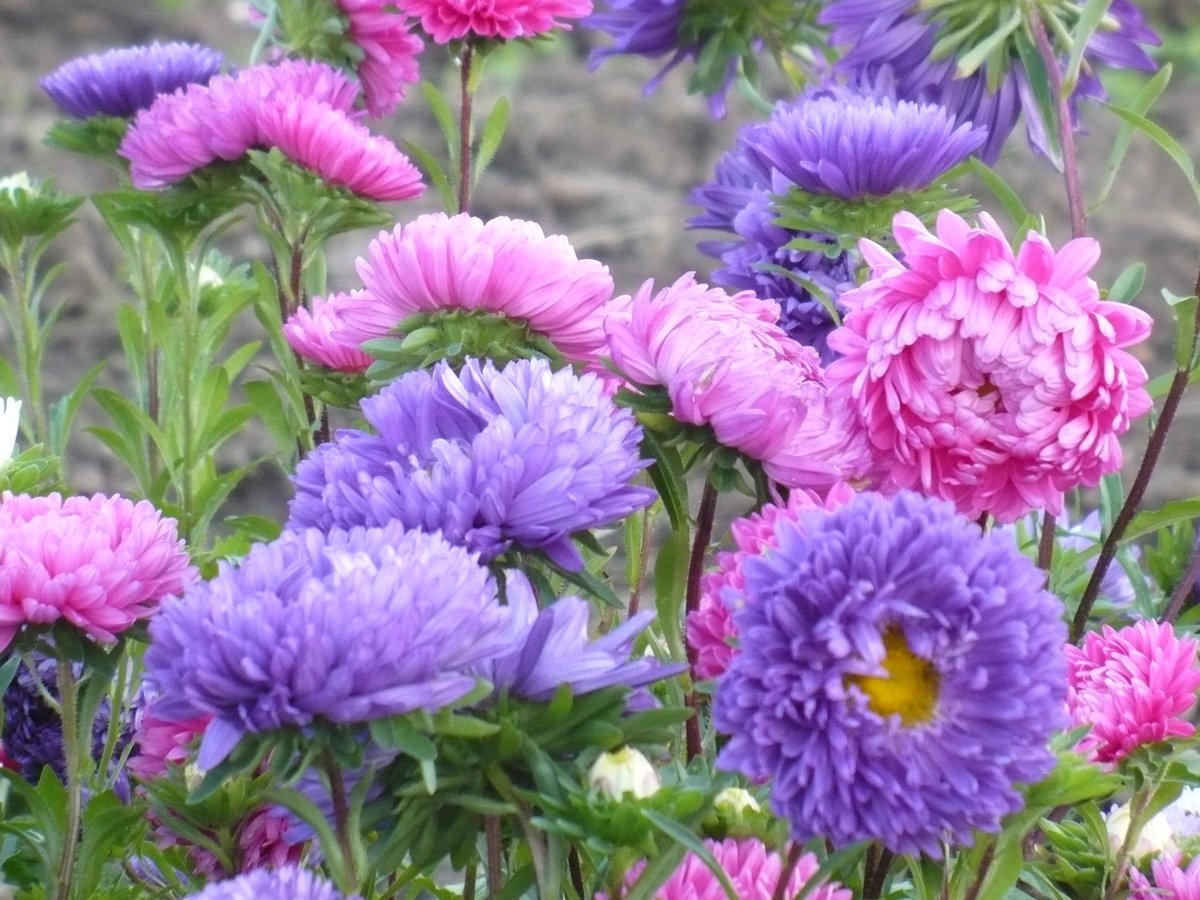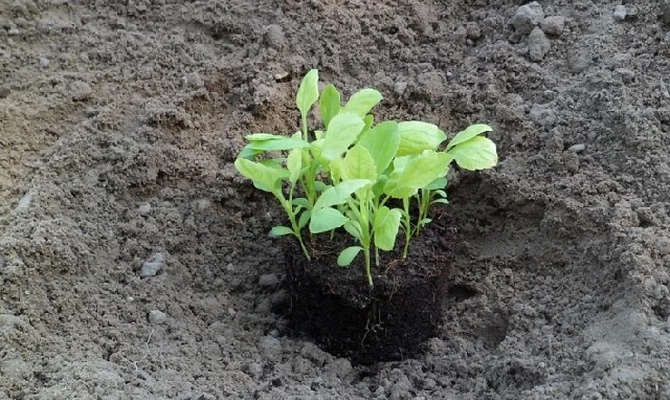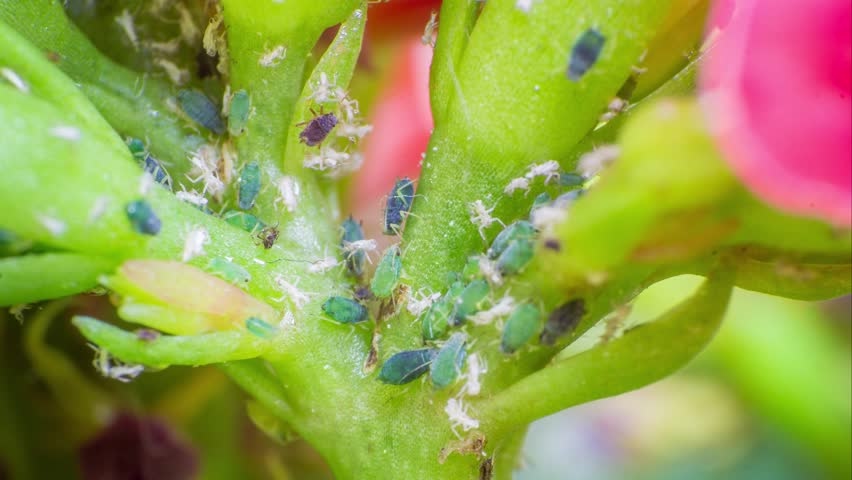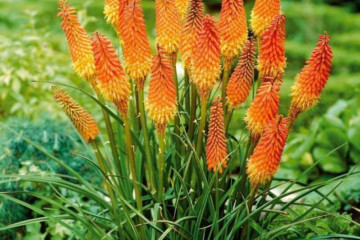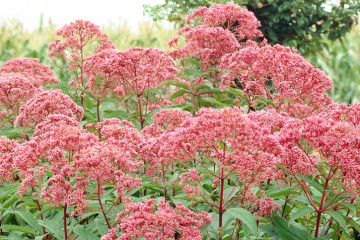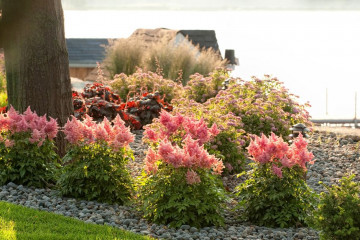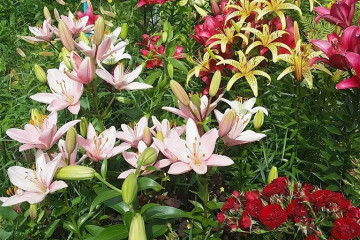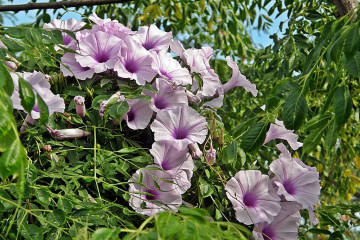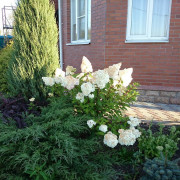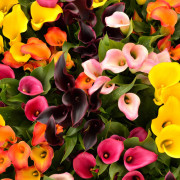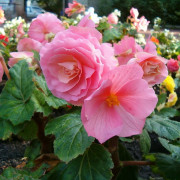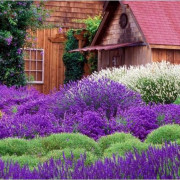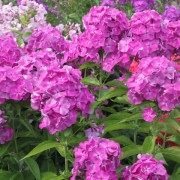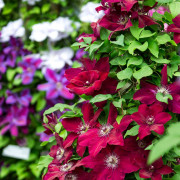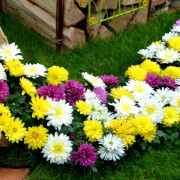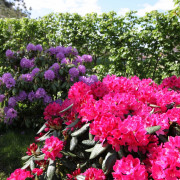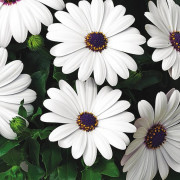Asters planting and care in the open field
Content:
Aster is a herbaceous rhizome plant from the Asteraceae family. It grows in bushes, can reach a height of 150 cm. The stems are straight and strong, the leaves are simple. The petals are tongue-shaped, of different lengths, collected in baskets. The closer to the center, the shorter the petals. The central ones are colored yellow, the color of the rest of the petals can be anything: blue, pink, orange, lilac, etc. The elongated seeds have a parachute for easy spreading. There are up to 200 types of asters. There are annual and perennial asters. The scientific name is callistephus.
Description of colors
Asters were brought to Europe from China. The name is translated from Latin as "star". A Chinese legend says that one day two monks decided to reach the stars by climbing the Altai mountains. Returning back with failure, they stumbled upon a meadow dotted with flowers, and one of the monks exclaimed: "We were looking for the stars in the sky, and they live on earth!" They called them with a speaking name - aster.
Asters, which do not require much effort to be planted and cared for outdoors, will beautify any garden. How to grow asters in the country, further.
Growing from seeds
Asters (growing from seed requires well-prepared soil) love slightly acidic soil. As a soil, they use ready-made mixtures or prepare the soil on their own: mix peat, turf, sand in a ratio of 2: 1: 0.5, add half a glass of wood ash (or 2 tablespoons of dolomite flour), sift and evaporate in a double boiler for an hour. If it is not possible to steam the soil, you can wet the soil with a saturated solution of potassium permanganate or fungicide. These measures are designed to protect seedlings from fungal infections in order to grow healthy seedlings.
At first, small containers are used. Fortified seedlings are transplanted into separate boxes, pots or cups. Astra tolerates picking well and develops in a large capacity.
Choosing the right time for sowing
When to plant asters for seedlings? The best time is early April. In a good greenhouse, it can be sown in March, but not earlier, since the seedlings will not have enough light.
Seed preparation and sowing
A week before sowing asters, their seeds are wrapped in cloth and soaked in a weak solution of potassium permanganate. After 12 hours, squeeze out excess moisture and put in a plastic bag and place in a warm place for germination.
Aster seeds are large, so they are planted less often.
For planting, grooves are made in the soil, seeds are poured there, sprinkled with a layer of sand on top and spilled with a solution of potassium permanganate through a sieve. Cover with foil or glass from above and leave to rise in a warm place.The emerging seedlings are placed in a cool place.
Properly prepared fresh seeds will sprout 5-10 days after planting.
How to care for seedlings
Watering the aster is necessary rarely and abundantly, but not flooding, since the flower can get sick with a black leg (fungus).
As soon as the first shoots appear, the container with the seedlings is placed in a sunny and cool place (on the windowsill).
Aster seedlings sprout well. If a nutritious soil has been prepared, fertilization is not necessary. With poor soil, seedlings are watered with biofertilizer or ash infusion a week after transplanting.
Site selection and soil preparation
Non-acidic fertile soil is suitable for asters. The place is chosen bright, sunny, in which water will not stagnate during watering.
Landing in open ground
Before planting asters outside, the plants are hardened: you need to take them outside or open the doors if the seedlings grow in a greenhouse. So it will more easily endure the "move" and possible cold snaps.
You can transplant seedlings into open ground from mid-May: ready-made shoots should be 10 cm in height and have leaves. The most fragile place of the sprout is where the stem passes into the root. To avoid injury, the flowers are watered abundantly and after half an hour they are removed from the soil with a toothpick or a match.
Seedlings are planted in grooves filled with water at a distance of 20-30 cm, up to half a meter is left between the grooves.
Planting in a seedless way
It is preferable to choose perennial asters, planting and care in the open field for which is not particularly difficult.
Growing aster flowers from seeds can be carried out immediately in the open field. This is done in early spring. Seeds are poured into shallow grooves, covered with soil a little on top and covered with a film. When shoots appear, the film must be removed. When three strong leaves appear, the sprouts are thinned out so that the distance between them is 10-15 cm. Excess seedlings must be carefully dug up and transplanted to another bed.
How to organize correct sowing in spring and before winter
Before winter, asters are planted in the fall, in October-November. When digging, fertilizers are added to the soil. The surface is leveled with a rake and grooves are made and covered with lutrasil until the first frost.
At the first frost, dry seeds are sown in prepared grooves and sprinkled with soil by 2 cm.
The bed is covered with plastic wrap, the edges are pressed down with slats or bricks. In this form, the sowing is left for the winter. In the spring, closer to April, polyethylene is replaced with a covering material.
If it was not possible to prepare the soil before the onset of frost, then with weak indicators, you can still plant: dig up the frozen soil, add ash or home humus and sow seeds.
Post-flowering care and preparation for winter
In preparation for winter, asters do not need to be fertilized (only if they are fresh plantings). To prune the plant or not is an individual choice. In both variants, it winters well. If the dried bushes are cut off, then the base must be covered with dry foliage. If the plant is weak, it is covered with spruce branches.
How asters breed
There are several options for how to propagate flowers.
Dividing the bush
Perennial asters are propagated by dividing the bush in the spring. It is not necessary to dig up bush asters, it is enough to divide it with a shovel. It is advisable to carry out the division process every 3-4 years, so the plant will rejuvenate and get rid of excess thickening, which contributes to damping off and the development of fungal diseases.
You can divide the bush into small parts with several buds. The next year, each part will become an independent plant.
Cuttings
Cuttings are carried out from May to August. The stem can be either the top of the stem or the entire stem. Choose a shaded place. Before planting asters, fertilize the garden with a mixture of turf, peat and sand in proportions of 2: 1: 1. The planted cuttings are covered with a film.
Features of plant care in the open field
Caring for asters is not difficult. What do you need to remember?
Temperature
The air temperature should not be too high, as this promotes the development of fungi.
Lighting
The place for the asters should be sunny, as the plant is not afraid of light. Can be planted in partial shade, but flowering will be less abundant.
Watering
The beds are watered as the soil dries up, avoiding waterlogging and not overdrying the soil.
In dry weather, the roots can be covered with dry grass or sawdust. If the weather is rainy, stop watering.
Spraying
Basically, seedlings or small sprouts are sprayed in the open field. In the first week, the procedure is carried out once a day, in the second - once every 2 days, in the third - 2 times a week.
Humidity
Soil moisture is required average. Deviations from the norm contribute to the development of fungi and plant decay.
Priming
The soil must be loose for oxygenation. It needs to be loosened regularly and weeds removed, this helps to protect against diseases.
Top dressing
Fertilizers are applied three times:
- 2 weeks after planting;
- during the formation of buds;
- before flowering.
Mineral fertilizers and wood ash are suitable.
When and how it blooms
Depending on the type, asters bloom in early summer or closer to autumn. They are divided into types according to the life span, the height of the bushes and flowering.
The most popular are asters:
- Chinese;
- alpine;
- Italian;
- Tatar;
- Siberian;
- dwarf varieties;
- chrysanthemum varieties;
- peony varieties.
Large flowers bloom on the following varieties of asters:
- Italian gnome;
- Galaxy;
- Gala;
- Oktyabrina;
- Snow White.
The smallest flowers in the species:
- dwarf alpine;
- New England (American);
- golden perennial.
Asters bloom for a long time, as many new buds form on the bushes. And one bud flaunts for 2-3 weeks, then gradually fades. Flowering lasts from June-July until the first frost.
Transplant after purchase and during reproduction
The plant tolerates transplanting well, the main thing is not to injure the roots, properly prepare the soil before planting asters (steam or pour potassium permanganate from pests and add humus).
Possible growing problems
What problems can a gardener face when growing asters?
Leaf problems
Leaves can turn yellow, lighten, dark stripes appear on them, swellings filled with spores can form. Eventually they curl up and dry out. All these are signs of an infection that has struck the plant.
Pests
Among the pests are:
- the slobbering penny produces a foam in which the larvae develop, devouring the leaves and stems of the flower. Because of this, growth slows down, and with severe damage, the plant dies. To combat the pest, tobacco decoction is used: 400 g is steamed in a bucket of water for 2 hours. Water is added to the finished decoction to 10 liters. A little laundry soap is also added so that the medicine sticks to the leaves;
- The meadow bug feeds on sap from flowers, stems and leaves, leaving behind white dots. To combat the parasite, the plant is sprayed with a solution of karbofos or pyrethrum;
- the spider mite also feeds on the sap of the plant, but settles on the back of the leaves, which is why they turn yellow and wither.To combat it, asters are sprayed with infusion of tobacco or onions. It can also be a decoction of yarrow;
- scoop gamma feeds on aerial parts of the plant. It is a caterpillar from which a brown butterfly with a pattern on the wings in the form of the Greek letter "gamma" hatches. Expelled by spraying with chlorophos or karbofos;
- bud aphids devour plants (especially tops) even at the seedling stage. To fight, spraying with chlorophos or karbofos is carried out.
Diseases
Possible diseases of asters:
- fusarium. The causative agent is a fungal infection. Viruses develop in the soil and enter the plant through the root system. The leaves begin to fade, turn yellow, curl, and dark spots appear. Appears quite rarely under favorable conditions (high temperatures). The affected plant must be removed, and the closely growing ones must be sprayed with a solution of copper oxychloride. Also, the soil is sprinkled with quicklime;
- blackleg. The causative agent is a fungal infection. Seedlings are affected: first they turn black, then the stem begins to rot. The diseased plant is removed, the rest are treated with a solution of bleach. The soil around the plants is sprinkled with sand;
- rust. Leaves swell on the back. Pustules filled with spores form. Affected plants are sprayed with a mixture of sulfur and lime in a 1: 1 ratio or Bordeaux liquid;
- jaundice. The causative agent is aphids and leafhoppers. Leaves begin to lighten and lose pigment. Growth slows down, the buds turn green. Affected plants are removed. To combat pathogens, spraying with pyrethrum or actellic is carried out. To prevent the disease, it is necessary to fight against aphids (spraying with a decoction or infusion of yarrow).
Signs of improper care
Although asters are considered unpretentious flowers, they still require some care.
- The flower is afraid of drought, but too much of it is also harmful: with a lack of water, the plant will dry out, with an excess, it will rot.
- Asters need weeding: this protects them from pests and diseases.
- The appearance of sores is also the result of improper maintenance or preparation of the soil.
In any case, asters are worth the time spent on them. The main thing is to choose a variety, plant it correctly and provide the required conditions. And then the flowers will delight the eye all summer until late autumn.
